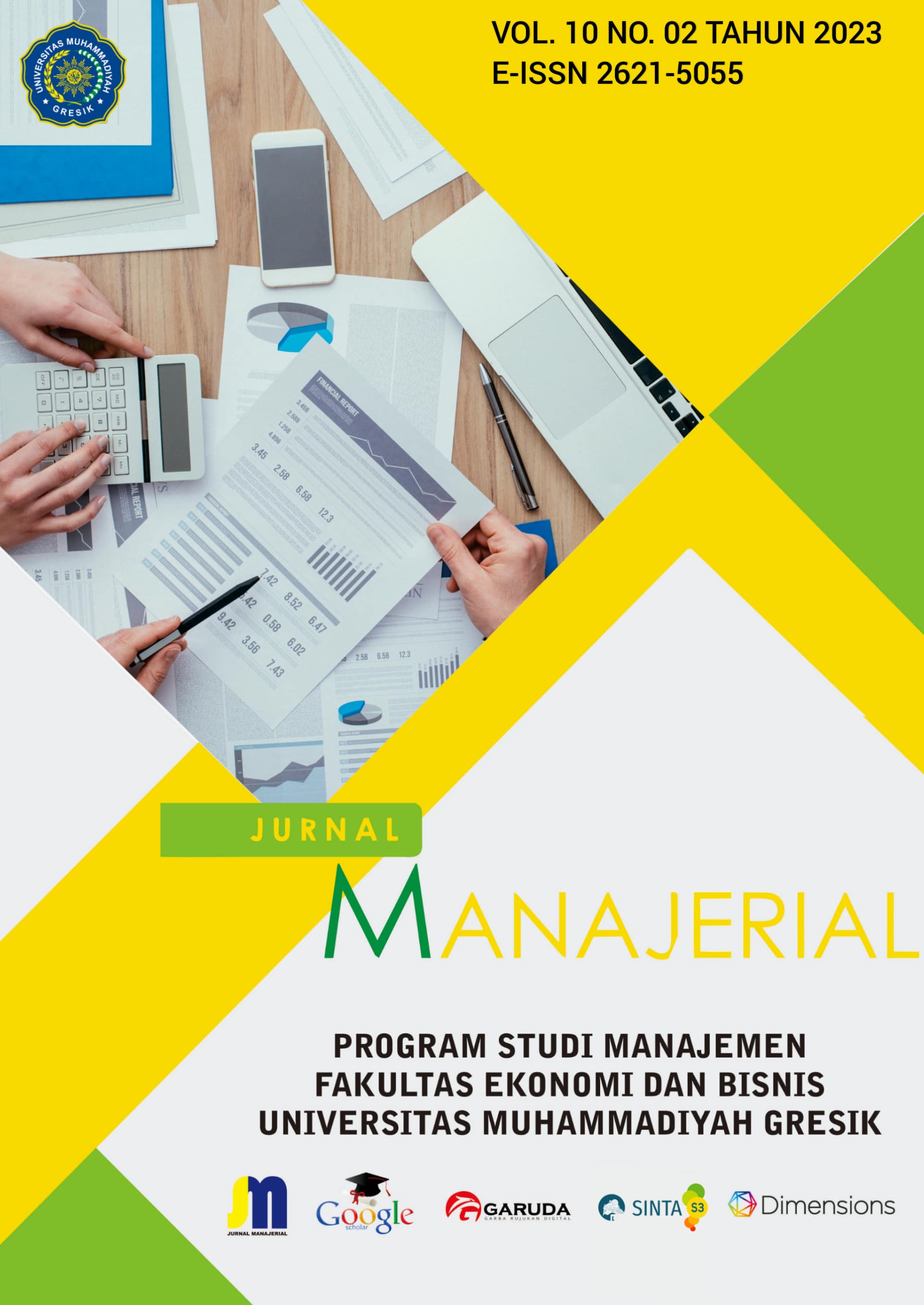An Analysis of Synergy Effect from Acquisition in PT Hakaaston and Its Subsidiary
DOI:
https://doi.org/10.30587/jurnalmanajerial.v10i02.5581Keywords:
Mergers, Acquisitions, SynergiesAbstract
Background – PT. Hakaaston has acquired three subsidiaries, namely PT. Bhirawa Steel, PT. Semen Indogreen Sentosa and PT. Catur Armindo Putra, which began in 2019. The acquisitions are generally expected to bring benefits to the acquiring company. However, after three years of implementing the acquisition, there has been no significant change, raising the question of whether the conducted acquisition that had been carried out was based on the right strategy and careful considerations.
Aim – This study aims to obtain the evidence regarding the effects of the acquisition conducted by PT. Hakaaston.
Design / Methodology / Approach – Researchers conducted an in-depth analysis of the condition using a mixed method approach to determine whether the acquisition that has been carried out could lead to financial synergies or operational synergies. The research process divided into several steps, the first step involved quantitative research, where the researcher conducted the statistical tests on the ratio of the company's financial reports of 2019-2022 which continued into the next step which involved qualitative in the form of in-depth analysis through interviews with informants. The results of statistical tests and interviews are integrated to allow the researcher to conclude whether synergy has been achieved from the acquisition.
Findings – The empirical findings based on post-acquisition financial statement report found that 2 out of 3 subsidiary companies experienced financial improvements while the holding company, as the acquirer, experienced a decline subsequent to the company’s acquisition. The result of the analysis interview with the informants explained that the conducted acquisition focus is not only on financial synergies but also on operational synergies in which the company played a role in supporting the construction of the Trans Sumatra Toll Road.
Conclusion - The initial quantitative analysis found that there is no significant financial or operational synergy among the subsidiary companies of PT. Hakaaston, meanwhile the qualitative analysis found that in terms of operational synergy, according to the informants from both the subsidiary companies and the holding company, operational synergy has been achieved.
Research implication – The findings of this study can serve as the basis for further research on Mergers & Acquisitions (M&A) policies which are not only beneficial for one party but more towards economic benefits. In addition, the research results can be used as a consideration in making decisions regarding future Mergers & Acquisitions (M&A) plans for companies to make them more effective.
Research Limitations – The limitation of this study is the relatively small-time frame of the research process, as the acquisition only took place in 2019. Therefore, future research can consider using a longer time frame to examine the post-acquisition period.
References
Alvarez-González, P., & Otero-Neira, C. (2023). Mergers and acquisitions success: examining customer loyalty. Marketing Intelligence & Planning, 41(1), 48-61.
Andriuškevičius, K. (2015). Opportunities and challenges of value creation through merger and acquisitions in cyclical economies. Procedia-Social and Behavioral Sciences, 213, 764-769.
Barnes (1987) explains that financial ratios can be used for every purpose, both in assessing a company's ability to pay its debts, evaluating business and managerial success and even statutory regulations regarding company performance.
Bradt, G. B., & Pritchett, J. (2022). The Merger & Acquisition Leader's Playbook: A Practical Guide to Integrating Organizations, Executing Strategy, and Driving New Growth after M&A or Private Equity Deals. John Wiley & Sons.
Brahma, S., Boateng, A., & Ahmad, S. (2018). Motives of mergers and acquisitions in the European public utilities: An empirical investigation of the wealth-anomaly. International Journal of Public Sector Management.
Bratianu, C., & Anagnoste, S. (2011). The role of transformational leadership in mergers and acquisitions in emergent economies. Management & Marketing, 6(2), 319.
Cho, M. H. (1998). Ownership structure, investment, and the corporate value: an empirical analysis. Journal of financial economics, 47(1), 103-121.
Creswell, J. W., & Creswell, J. D. (2005). Mixed methods research: Developments, debates, and dilemmas. Research in organizations: Foundations and methods of inquiry, 2, 315-326.
Creswell, J. W., & Creswell, J. D. (2017). Research design: Qualitative, quantitative, and mixed methods approaches. Sage publications
Das, A., & Kapil, S. (2012). Explaining M&A performance: a review of empirical research. Journal of Strategy and Management, 5(3), 284-330.
Gudmundsson, S. V., Merkert, R., & Redondi, R. (2020). Cost structure effects of horizontal airline mergers and acquisitions. Transport policy, 99, 136-144.
Gupta, I., Mishra, N., & Tripathy, N. (2021). The impact of Merger and Acquisition on value creation: an empirical evidence. In The Importance of New Technologies and Entrepreneurship in Business Development: In The Context of Economic Diversity in Developing Countries: The Impact of New Technologies and Entrepreneurship on Business Development (pp. 1435-1456). Springer International Publishing.
Harrison, R. T., Botelho, T., & Mason, C. M. (2016). Patient capital in entrepreneurial finance: a reassessment of the role of business angel investors. Socio-Economic Review, 14(4), 669-689.
Hossain, M. S. (2021). Merger & Acquisitions (M&As) as an important strategic vehicle in business: Thematic areas, research avenues & possible suggestions. Journal of Economics and Business, 116, 106004.
Jumingan, D. (2006). Analisis laporan keuangan. Jakarta: PT. Bumi Aksara.
Kwilinski, A., Slatvitskaya, I., Dugar, T., Khodakivska, L., & Derevyanko, B. (2020). Main effects of mergers and acquisitions in international enterprise activities. International Journal of Entrepreneurship, 24, 1-8.
Lee, R., Lee, J. H., & Garrett, T. C. (2019). Synergy effects of innovation on firm performance. Journal of Business Research, 99, 507-515.
Li, Z., Li, Q., & Zeng, Y. (2020). Contraction flexibility, operating leverage, and financial leverage. Journal of Management Science and Engineering, 5(1), 43-56.
Li, C., Shi, Y., Wu, C., Wu, Z., & Zheng, L. (2016). Policies of promoting entrepreneurship and Angel Investment: Evidence from China. Emerging Markets Review, 29, 154-167.
Lin, Y. E., Li, Y. W., Cheng, T. Y., & Lam, K. (2021). Corporate social responsibility and investment efficiency: Does business strategy matter?. International Review of Financial Analysis, 73, 101585.
McCarthy, K. J., & Aalbers, H. L. (2022). Alliance-to-acquisition transitions: The technological performance implications of acquiring one's alliance partners. Research Policy, 51(6), 104512.
Munawir, S. (2012). Manajemen keuangan. Yogyakarta: BPFE.
Natocheeva, N. N., Rovensky, Y. A., Belyanchikova, T. V., & Rusanov, Y. Y. (2017). The diversification of banking capital sources and cash flow granularity in merger and acquisition transactions.
Porrini, P. (2004). Can a previous alliance between an acquirer and a target affect acquisition performance?. Journal of management, 30(4), 545-562.
Pratiwi, S. M., Miftahuddin, M., & Amelia, W. R. (2020). Pengaruh Current Ratio (CR), Debt To Equity Ratio (DER), Dan Earning Per Share (EPS) Terhadap Harga Saham Pada PT. Indofood Sukses Makmur Tbk. Jurnal Ilmiah Manajemen dan Bisnis (JIMBI), 1(2).
Rabier, M. R. (2017). Acquisition motives and the distribution of acquisition performance. Strategic Management Journal, 38(13), 2666-2681.
Risberg, A. (Ed.). (2013). Mergers & acquisitions: A critical reader. Routledge.
Sheikh, M. J., Ahmed, M., Arshad, Q., & Shakeel, W. (2015). Mergers and Acquisitions as Vital Instruments of Corporate Strategy: Current and Historical Perspective. Journal of Asian Finance, Economics and Business, 2(1), 15-21.
Smeulders, D., Dekker, H. C., & Van den Abbeele, A. (2019). Information availability in acquisition decisions: The role of prior relations and rival bidders. Journal of Management Accounting Research, 31(3), 201-228.
Tang, Q., Guo, J., & Huang, Z. (2021). The role of accounting conservatism in M&A target selection. China Journal of Accounting Research, 14(4), 100204.
Vu, D. A., & Moisescu, O. I. (2013). Brand integration practices in mergers and acquisitions. Management & Marketing, 8(3), 403.
Wang, D., Hain, D. S., Larimo, J., & Dao, L. T. (2020). Cultural differences and synergy realization in cross-border acquisitions: The moderating effect of acquisition process. International Business Review, 29(3), 101675.






























 P-ISSN: 2354-8592 __ E-ISSN: 2621-5055
P-ISSN: 2354-8592 __ E-ISSN: 2621-5055 
